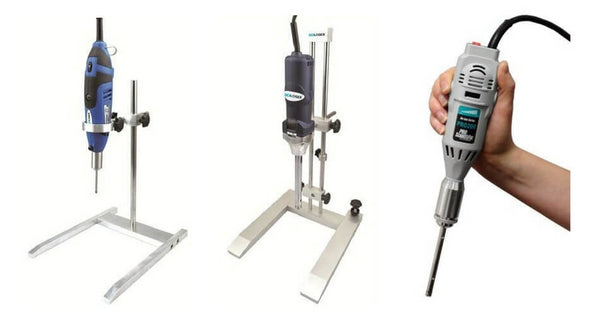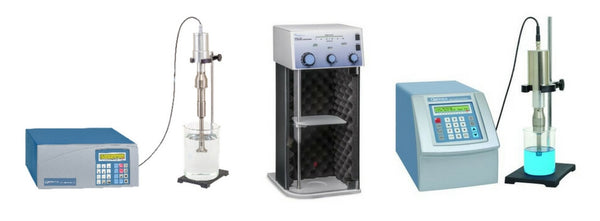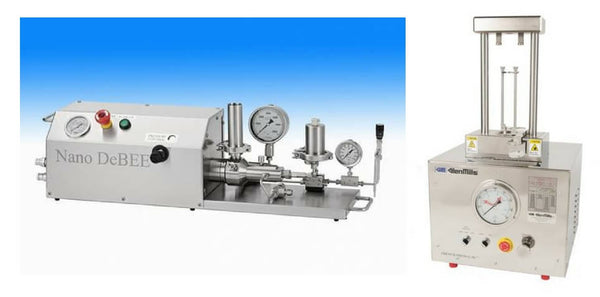Homogenization is a helpful technique in numerous applications, including particle size reduction, emulsification, tissue homogenization and dissociation, and cell disruption.
And with the wide variety of applications comes a list of different homogenizer technologies, each suitable for different uses. The main types of homogenizer technology are:
- Rotor-stator
- Ultrasonic
- Bead mill
- High-pressure
- Paddle blender
- Mortar and pestle
Some of the main points of difference in the various technologies that make them more suitable for one application or another including level of shear, sample capacity, throughput capacity, reproducibility, and scalability. Other considerations will include cost and ease-of-use.
In this post, we’ll discuss the various homogenizer technologies and some of their use cases to help you decide which is best for your application.
Specific Applications and Suggested Homogenizer Technologies
Before we talk about the different technologies available, we’ll look at some specific application examples and suggested suitable technologies.
Application |
Suggested homogenizer technologies |
|
|
|
|
|
|
|
|
|
|
|
|
|
|
|
|
|
The Main Types of Homogenizer Technology Available
Now that we’ve covered what technologies might be suitable for certain applications, let’s take a closer look at each technology, including its benefits and drawbacks.
1. Rotor-Stator Homogenization

Left to right: A D160 Homogenizer, D500 Homogenizer, and Bio-Gen PRO200 Homogenizer.
A rotor-stator homogenizer comprises a metal shaft (rotor) which rotates rapidly within a stationary outer case (stator). This creates a suction effect such that the sample is drawn into the space between the two components. Here it is subject to very high-shear forces which help to homogenize the liquid or particles.
A continuous process is formed as the sample is pushed through slots in the stator. The rapid motion of the fluid results in more sample entering the space to be subjected to shear.
Uses
These homogenizers are suitable for applications involving liquids and suspensions, including mixing or emulsifying. They can also be used for lysing cells and homogenizing soft tissue.
Benefits
- The ability to switch between probes means a large volume range can be covered.
- This process offers a fast and efficient approach for single samples.
Drawbacks
- The use of probes means that rotor-stator homogenizers are not suitable for multi-sample high-throughput applications.
- Rotor-stator homogenizers do impart a moderate amount of heat, so you may have to cool heat-sensitive samples.
More information can be found on the Rotor-Stator Homogenization page within our Application Center.
2. Ultrasonic Homogenization

Left to right: A Q2000 Sonicator, 3000 Ultrasonic Homogenizer, and Q500 Sonicator.
Ultrasonic homogenizers (also known as sonicators) also involve the use of a probe (horn). The probe vibrates rapidly and transfers its ultrasonic energy to the surrounding sample. In addition, the sonication process results in cavitation, which involves the rapid formation and collapse of bubbles. This creates shockwaves which homogenize the surrounding sample.
Ultrasonic homogenizers can achieve small particle sizes with relatively short processing times. Using one of these homogenizers will result in a lot of noise being created so ear protection should be used.
Uses
Common uses for ultrasonic homogenizers are particle size reduction, cell or tissue disruption, and DNA shearing. This equipment is designed for use with liquid samples and cannot be used with dry samples.
Benefits
- They can impart a large amount of energy over a small area.
- They can achieve small particle sizes in a relatively short period of time.
Drawbacks
- The process may result in trace amounts of titanium ending up in the sample, which may be a concern for certain applications.
- Ultrasonic homogenizers can generate a large amount of heat so may not be suitable for heat-sensitive applications.
More information can be found on the Ultrasonic Homogenization page within our Application Center.
3. Bead Mill Homogenization

Left to right: A Precellys® 24, BeadBug™ 6, and HT Lysing Bead Mill Homogenizer.
As its name suggests, a bead mill homogenizer involves the use of beads. The sample is placed with the beads in a tube, which is then agitated vigorously. As a result of the movement of the beads and the collisions between them, the sample is homogenized.
The type of motion used to agitate the beads differs for various machines, but it is typically done via vigorous shaking.
Uses
Multiple samples can be homogenized simultaneously making this application suitable for high-throughput applications. Some uses include breaking up tissue and disrupting cells. Bead mills can be used with dry samples so can be suitable for milling or grinding solids.
Benefits
- Disposable tubes are used, meaning there is very little chance of contamination.
- Tubes are closed so the risk of aerosolization is decreased.
- Different types of beads are available for various uses, broadening the potential application range.
Drawbacks
- The nature of the process means that laboratory-scale bead mill homogenization is only suitable for small samples. A few grams or milliliters is all you can usually process in a single tube.
- Small amounts of the bead material may find its way into your sample, which might be a concern for some applications.
More information can be found on the Bead Mill Homogenization page within our Application Center.
4. High-Pressure Homogenization

Left to right: A Nano DeBEE High Pressure Homogenizer and French Press G-M®.
There are various types of high-pressure homogenizers out there and this is more of a general term for the process rather than a description of the equipment itself. High-pressure homogenization involves a primarily liquid sample being subjected to a strong force that homogenizes it.
A common setup involves the sample being forced through a channel, for example through a valve or tiny slits in a membrane. The resulting shear, pressure drop, and cavitation will homogenize the sample. In some cases, homogenization is aided by the high-pressure stream colliding with a blade, plate, or ring.
Uses
The most common use cases for high-pressure homogenization are those in which large volumes need to be homogenized. Many models allow for recycling and this, coupled with vigorous processing, can allow for the achievement of very small particle sizes.
Benefits
- Some high-pressure homogenizers allow for a lot of flexibility, making them suitable for a broader range of applications.
Drawbacks
- These machines are often large and cumbersome, and come with a hefty price tag.
More information can be found on the High-Pressure Homogenization page within our Application Center.
5. Paddle Blender Homogenization

Left to right: A Stomacher® 400 Circulator, Stomacher® 80 Biomaster, and BagMixer 400.
A paddle blender (often called a stomacher) is very different from the other pieces of equipment on the list as it doesn’t actually create a homogeneous mixture. In this case, a solid sample is squeezed by paddles against a solid surface so that the desired contents are extracted. This is usually bacteria or other microbes, or live cells, which end up circulating in solution.
Uses
Paddle blender homogenizers are designed specifically for the extraction or washing of microorganisms into solution. They are used extensively for food and environmental testing applications as well as in life science research. They can also be suitable for certain applications where tissue dissociation is desired.
Benefits
- Works well for its specific applications.
Drawbacks
- Paddle blender bags can be difficult to handle and store so it's important to do your research before making your decision.
- A paddle blender has limited utility outside of the specific applications it is designed for.
More information can be found on the Paddle Blenders page within our Application Center.
6. Mortar and Pestle Homogenization

Left to right: A BioPulverizer, MicroMincer, Tissue Grinder, and Talboys Cryogenic Homogenizer.
The good old mortar and pestle method has long been used for homogenization. The sample is held in a container (mortar) and pressed with a blunt object (pestle). This grinds the sample, homogenizing it. There are specially-designed mortar and pestles for various applications but technically, even a rod pressed in a tube could be considered a mortar and pestle.
Specialized versions are often designed to have a very tight fit for more efficient homogenization. Examples include dounce, Potter, Potter-Elvehjem, and Tenbroeck homogenizers. Aside from manually operated options, there are some low-power motorized versions available, where the pestle is spun to create additional shear force.
Uses
Mortar and pestles can generally only process small samples, one at a time, which limits their application potential. However, when it comes to the type of sample, the only real limitation is that materials in the sample can’t be harder than the mortar and pestle themselves. The range of potential composition materials means that mortar and pestles can be made to withstand cryogenic temperatures which can be particularly useful in life science applications.
Benefits
- They are very low cost and easy to use.
Drawbacks
- Mortar and pestle homogenization is usually manual so human error can come into play and reproducibility can be an issue.
- The process is not scalable.
More information can be found on the Mortar and Pestle Homogenization page within our Application Center.
